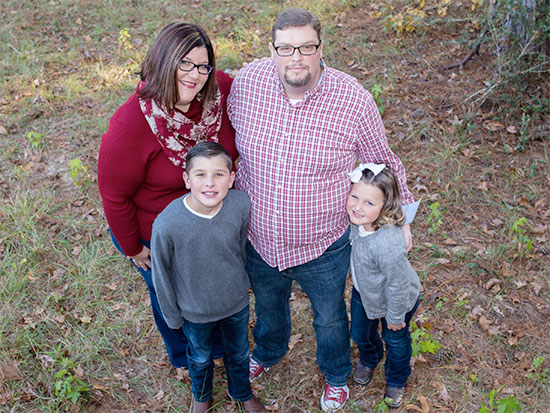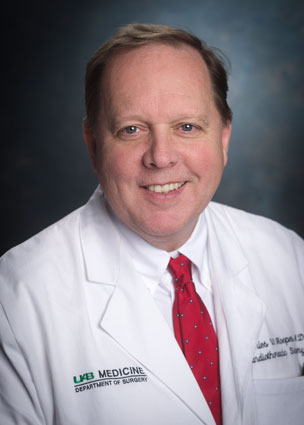Written by: Danielle Deavours, UAB Medicine
Media contact: Adam Pope
 Martin and his family have much to look forward to now that he has a new heart and new lungs.Fort Walton Beach, Fla., resident Brad Martin is thankful to be able to blow out the candles on his birthday cake, something he couldn’t do just two years ago. After receiving a lung transplant from the Comprehensive Transplant Institute in 2015, he now credits UAB Medicine for breathing new life into him.
Martin and his family have much to look forward to now that he has a new heart and new lungs.Fort Walton Beach, Fla., resident Brad Martin is thankful to be able to blow out the candles on his birthday cake, something he couldn’t do just two years ago. After receiving a lung transplant from the Comprehensive Transplant Institute in 2015, he now credits UAB Medicine for breathing new life into him.
Martin, 42, first began experiencing serious health issues in May 2001 after graduating from college. His initial symptoms were severe shortness of breath and difficulty walking.
“I was at my first job, and I was walking down the halls,” he said. “I couldn’t even walk 10-30 feet without having to stop. My face was red, and it was hard to breathe. I would get headaches all the time just from the sheer lack of oxygen.”
Despite these difficulties, Martin says it took him a couple of months to see a doctor. Between planning for his wedding and working more than 60 hours a week, Martin says he didn’t put his health first.
“My wife continuously tried to get me to go to the doctor, and it took me about four months to get checked out,” he said. “I think I realized something was seriously wrong, and I just wasn’t ready to deal with it.”
A distressing diagnosis
Martin saw a cardiologist in Florida who diagnosed him with pulmonary arterial hypertension, or high blood pressure in the lungs. PH often leads to heart failure. Martin —who was 27 years old at the time — says his wife had a hard time with the diagnosis.
“My wife and I got out of that appointment, and she was distraught,” he said. “We had just gotten married four months before that. It was a lot harder for her I think because deep down I had already accepted that something really bad was happening.”
Martin was given IV medication that was pumped into his body through a port 24/7. He says it was difficult to live a normal life because of the medication.
| “I consider UAB to be one of the best hospitals in the country. I would rather drive three hours and get topnotch care than go 30 minutes down the road to someone who probably didn’t even care that I was sitting in their office.” |
“I lived that way for 14 years, and in those 14 years, I couldn’t take a shower, only baths,” he said. “I couldn’t swim. It was especially difficult when we started having children because there was so much I couldn’t do with them.”
A few years after Martin was diagnosed, he and his wife had their first son, Chase. At that time, Martin learned that he didn’t have a normal pulmonary hypertension diagnosis.
“We found out during her pregnancy that it was genetic, which is extremely rare and a lot more serious,” Martin said. “They were able to check me for the marker during her pregnancy, and mine was positive. A couple of years later, we had our son genetically tested. They found the same marker in him, so we knew we would have to deal with it at some point for Chase as well.”
Martin’s condition soon started to deteriorate, and in 2005 he transferred his cardiology care to UAB Medicine. Martin says the care he received at UAB was outstanding and worth the time it took to get there.
“I consider UAB to be one of the best hospitals in the country,” he said. “If I had to see a doctor for anything, I would drive the three hours to go to UAB. I would rather drive three hours and get topnotch care than go 30 minutes down the road to someone who probably didn’t even care that I was sitting in their office.”
Martin’s pulmonary hypertension continued to worsen. In 2013, he was told he needed a heart and lung transplant.
“I don’t think I knew what to think when they told me that I’d need a transplant,” he said. “I was still young, and you have this mentality that nothing bad is going to happen to you, that you’re invincible. Even though I had pulmonary hypertension, I thought I was doing OK, and at that point, I had never thought that I might actually die from this. The reality of being told that, if I didn’t get a transplant within a few years, I would die was very eye-opening. I started thinking of all the things I needed to do, how to prepare my family for when I was gone. My whole outlook on life changed in that moment.”
 Charles Hoopes, M.D.A donor is found
Charles Hoopes, M.D.A donor is found
Martin was placed on the transplant list in 2014 for both a heart and lungs. He waited a year and a half before a donor was found, eventually being placed under the care of Charles Hoopes, M.D., professor in the Division of Cardiothoracic Surgery and director of lung transplantation. Martin says Hoopes was instrumental in finding the right match, especially when complications arose.
“Dr. Hoopes was hired six months before my transplant, and in our first consultation, he told me he was going to find me a set of lungs, and three months later he had me on the operating table,” Martin said. “That speaks volumes to his dedication to his patients because he had contacts across the U.S. helping him find donors.”
Martin originally was supposed to receive a heart and lung transplant; but on the day of his surgery, Hoopes told him they hadn’t been able to get the heart for him. Martin had to decide whether to receive the lungs only or wait for another set of organs to be found.
“I had to make that life-changing decision with my wife,” he said. “I was in such bad shape that we really didn’t know how much longer I would make it,” Martin said. “Part of the reason we chose to go ahead was we knew Dr. Hoopes was there. I told my wife that God wouldn’t have given us this choice and this doctor if He didn’t think it was right. So, we took the lungs and left the rest in God’s hands.”
Martin was in surgery for 13 hours. He says they knew they had made the right choice when Hoopes came out to talk to his wife after surgery.
“Dr. Hoopes told her that the surgery went very well,” Martin said. “He told her that no one knew how bad a shape I was in until they were operating. The right side of my heart was three times larger than the left, and he said I likely wouldn’t have made it six months in that shape. We were so blessed that we took the lungs.”
Martin’s recovery was difficult. He didn’t wake up for six days because he had to be placed on a ventilator in order to have enough time to strengthen his heart muscles. Even when he woke up, he was in a lot of pain and stayed in intensive care for seven weeks. He says, through it all, the care he received from the CTI team meant the world to him and his wife.
“They made that experience one of the best in my life,” Martin said. “I don’t know many people who would say transplant surgery is the best experience in their life, but the doctors and nurses at UAB made it that way for us. We were so happy with our decision to change over to UAB all those years before because of the awesome care they gave me.”
After being released from the hospital, Martin moved to Alabama for three months as he worked to get back to normal. Now, two years post-transplant, Martin is back in Florida with his family, enjoying his new lease on life.
“To go from sitting on the couch each day thinking I was going to die to not being sick at all for almost two years — there just aren’t the right words to talk about that,” Martin said. “I can pick up my kids and take walks with them without feeling like I’m going to die with every step. I can do things outside. We go camping a lot, which I never would have done before the transplant. I even traveled to Europe for the first time in my life because there was a period before the transplant that I couldn’t even leave home. I feel wonderful. I’m thankful every day that I can just breathe.”
His son’s future
Martin’s care team estimates that his lungs will last 10-20 years. He says, more than anything, he wants to use the time he’s been given to be there for his family, especially given the potentially difficult times that lie ahead.
| “UAB is great for their ability to do new research and find new technology for these diseases and transplants. I’m always hopeful that something better will be there for Chase. |
“My son Chase is now 10 and living with pulmonary hypertension,” he said. “He has to watch his friends at school go and play, and he can’t do that. He mentally goes through a lot. But he’s a great kid and doesn’t act like anything’s different. Hopefully I’m going to be a good example for him because we know he’s going to have to have a transplant too. We’re getting prepared for that now. I just want to be there when it happens to support my wife so she doesn’t have to take care of him alone.”
Martin says he hopes that research at institutions such as UAB can help Chase’s prognosis in the future, but he knows that time is of the essence.
“UAB is great for their ability to do new research and find new technology for these diseases and transplants,” he said. “I’m always hopeful that something better will be there for Chase, but we just don’t know if it’ll happen in the timeframe he needs it.”
A second chance
Martin says his son and other people on the transplant waiting list are the reasons organ donors are needed.
“In our area especially, organs are harder to come by, and the more people who can donate, the better,” he said. “I think everyone should be an organ donor.”
This year, UAB is celebrating 50 years of transplantation in Alabama. In 1968, surgeons from UAB performed the first transplant in the state. Since then, UAB Medicine has successfully completed more than 14,000 organ transplants.
Learn more about UAB Medicine’s Comprehensive Transplant Institute and how to share the gift of life by becoming an organ donor.